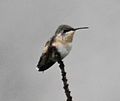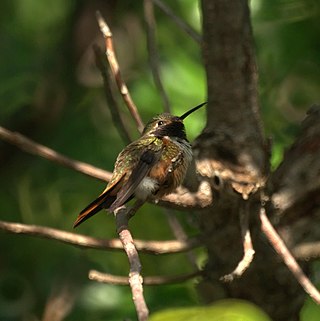
The Bahama woodstar or Bahama hummingbird is a species of hummingbird endemic to the Lucayan archipelago, including the Bahamian and Turks and Caicos islands. It is named the "hummer" by locals due to a distinct humming sound it makes while feeding.

Trochilinae is one of the six subfamilies that make up the hummingbird family Trochilidae.

The blue-chested hummingbird is a species of hummingbird in the family Trochilidae. It is found in Colombia, Costa Rica, Ecuador, Nicaragua, and Panama. Its natural habitats are subtropical or tropical moist lowland forest and heavily degraded former forest.

The charming hummingbird and also known as the beryl-crowned hummingbird is a species of hummingbird in the family Trochilidae, found in Costa Rica and Panama. Its natural habitats are subtropical or tropical moist lowland forest and heavily degraded former forest. Staying within the exterior of forests, it searches for scattered flowers and various arthropods for food.
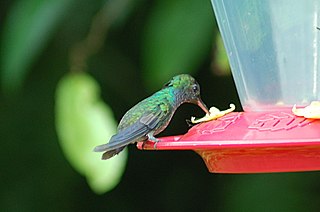
The purple-chested hummingbird is a species of hummingbird in the family Trochilidae. It is found in Colombia and Ecuador. Its natural habitats are subtropical or tropical moist lowland forest and heavily degraded former forest. It is commonly hunted for the supposed medicinal properties of its beak by indigenous peoples in the area.

The amethyst woodstar is a species of hummingbird in tribe Mellisugini of subfamily Trochilinae, the "bee hummingbirds". It is found in every mainland South American country except Chile and Uruguay and has been recorded as a vagrant on Trinidad.

The Tumbes hummingbird is a species of hummingbird in the "emeralds", tribe Trochilini of subfamily Trochilinae. It is found in Ecuador and Peru.

Polyerata is a genus of hummingbirds.
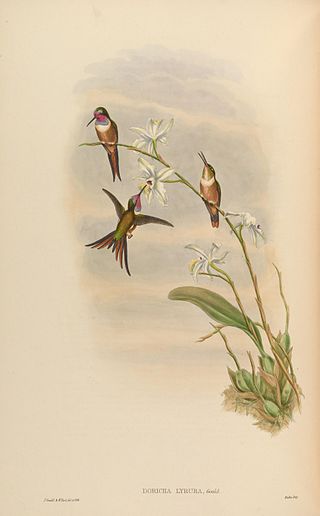
The Inagua woodstar, also called the lyre-tailed hummingbird, is a species of hummingbird in tribe Mellisugini of subfamily Trochilinae, the "bee hummingbirds". It is endemic to the two islands of the Inagua district of the Bahamas.

Nesophlox is a genus in the family of Hummingbirds. It consists of two endemic hummingbirds of the Bahamas.
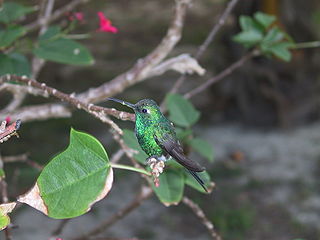
Riccordia is a genus of birds in the hummingbird family Trochilidae. They are endemic to the Caribbean.

Elliotomyia is a genus in the family of Hummingbirds.
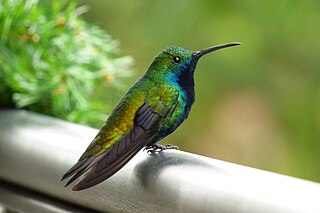
Polytminae is one of the six subfamilies of the hummingbird family Trochilidae. The subfamily contains 12 genera with a total of 29 species.
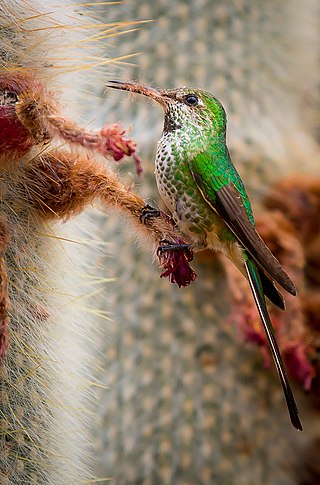
Lesbiinae is one of the six subfamilies that make up the hummingbird family Trochilidae.
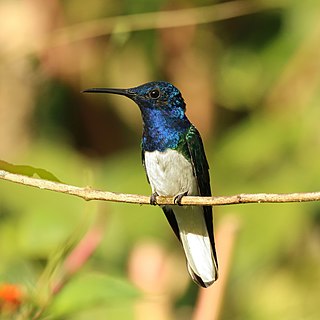
Florisuginae is one of the six subfamilies in the hummingbird family Trochilidae.

Heliantheini is one of the two tribes that make up the subfamily Lesbiinae of the hummingbird family Trochilidae. The other tribe in the subfamily is Lesbiini.

Lesbiini is one of the two tribes that make up the subfamily Lesbiinae in the hummingbird family Trochilidae. The other tribe is Heliantheini (brilliants).

Lampornithini is one of the three tribes that make up the subfamily Trochilinae in the hummingbird family Trochilidae. The other two tribes in the subfamily are Mellisugini (bees) and Trochilini (emeralds).

Trochilini is one of the three tribes that make up the subfamily Trochilinae in the hummingbird family Trochilidae. The other two tribes in the subfamily are Lampornithini and Mellisugini (bees).

Philodice is a genus of hummingbirds in the tribe Mellisugini and family Trochilidae.




